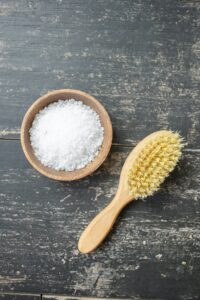Choosing the Right Exfoliant

Exfoliation is a vital step in a skincare routine that is often overlooked. It involves removing the dead skin cells that accumulate on the surface of our skin, which can lead to a dull and lackluster appearance. Not only does exfoliation reveal a brighter complexion, but it also helps to unclog pores and prevent breakouts. However, it’s important to know how to do it safely to avoid damaging your skin.
Why is exfoliation important?
Our skin is constantly shedding dead skin cells, but sometimes they can accumulate and create a barrier that prevents skincare products from penetrating deeply into the skin. Exfoliation helps to remove this barrier, allowing for better absorption of moisturizers, serums, and other products. It also helps to smooth out the texture of the skin, making it appear more youthful and radiant.
Exfoliation can also help to prevent breakouts by unclogging pores. When dead skin cells accumulate, they can mix with oil and bacteria on the skin’s surface, leading to pimples, blackheads, and whiteheads. By removing these dead skin cells, you can help to prevent this buildup and keep your skin clear.
How to exfoliate safely
There are two main types of exfoliation: physical and chemical. Physical exfoliation involves using a scrub or brush to physically remove dead skin cells, while chemical exfoliation uses acids to dissolve them.
When it comes to physical exfoliation, it’s important to choose a product that is gentle and won’t cause micro-tears in the skin. Look for exfoliants that contain small, round beads or gentle acids like lactic acid, which can help to dissolve dead skin cells without causing damage. Avoid exfoliants with large, jagged particles like apricot kernels, which can cause micro-tears in the skin and lead to inflammation and sensitivity.
Chemical exfoliants are a great option for those with sensitive skin or who are prone to redness and irritation. Look for products that contain alpha-hydroxy acids (AHAs) like glycolic acid or beta-hydroxy acids (BHAs) like salicylic acid. AHAs work by breaking down the bonds that hold dead skin cells together, while BHAs penetrate deep into the pores to dissolve oil and unclog them.
When using a chemical exfoliant, start with a low concentration and gradually work your way up as your skin becomes accustomed to it. It’s also important to wear sunscreen during the day, as AHAs and BHAs can make your skin more sensitive to the sun.
No matter what type of exfoliant you choose, it’s important to be gentle and not overdo it. Over-exfoliation can lead to irritation, sensitivity, and even damage to the skin’s natural barrier. Aim to exfoliate no more than twice a week, and avoid using an exfoliant on the same day as a retinol or vitamin C product, which can also be irritating to the skin.
In addition to being gentle, it’s also important to choose an exfoliant that is appropriate for your skin type. If you have oily or acne-prone skin, a BHA like salicylic acid may be more effective in unclogging pores and preventing breakouts. If you have dry or sensitive skin, a gentle AHA like lactic acid may be a better option.

Other tips for safe exfoliation
In addition to choosing the right exfoliant and being gentle, there are a few other tips to keep in mind for safe exfoliation:
- Avoid exfoliating if your skin is already irritated, sunburned, or has an active breakout.
- Use lukewarm water when washing your face, as hot water can strip the skin of its natural oils and make it more prone to irritation and dryness.
- Always follow up with a moisturizer after exfoliating to help restore hydration and protect the skin’s natural barrier.
- Don’t forget to exfoliate other parts of your body, such as your hands, feet, and legs. Use a body scrub or exfoliating mitt to gently remove dead skin cells and reveal softer, smoother skin.
- If you have sensitive skin or are unsure about how to exfoliate safely, consult with a dermatologist or esthetician who can recommend the best products and techniques for your skin type.
In conclusion, exfoliation is a crucial step in any skincare routine. By removing dead skin cells, you can reveal a brighter, smoother complexion and prevent breakouts. However, it’s important to choose the right exfoliant and be gentle to avoid damaging your skin. Whether you prefer physical or chemical exfoliation, following these tips can help you exfoliate safely and achieve the glowing, healthy skin you deserve.




